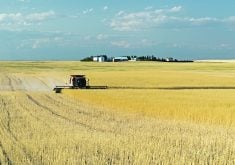Thinking about selling some of that farmland that is a little too far from home or that just isn’t the right fit for your operation? Have your eyes set on another parcel? If so, you might be able to take advantage of the replacement property rules to defer the capital gain on the parcel you want to sell.
The replacement property rules allow you to defer the recognition of a capital gain on the sale of capital property, such as farmland, if certain conditions are met. For the purposes of this article, only voluntary sales are discussed, but the rules may also apply in certain situations where you have involuntarily disposed of a capital property.
Read Also

Proactive approach best bet with looming catastrophes
The Pan-Canadian Action Plan on African swine fever has been developed to avoid the worst case scenario — a total loss ofmarket access.
What are the conditions to apply the replacement property rules?
First, you must be disposing of a “former business property.” To be a “former business property,” the property must be:
- A capital property that is either real or immoveable property or an interest in or right to such property.
- Used by you or a person related to you primarily for the purpose of gaining or producing income from a business.
Notably, a “former business property” does not include rental property, which, for the purposes of the replacement property rules, means real or immovable property owned by you (whether alone or jointly) and used by you principally (for example, more than 50 percent) for the purpose of gaining or producing gross revenue that is rent.
You might be wondering when or for how long you have to be primarily using the property for the purpose of gaining or producing income in order for it to qualify. The term “primarily” is interpreted to mean 90 percent or more of the use of the property in the tax year in which it is sold, such as immediately prior to the sale.
The second part of the test is acquiring a “replacement property.” Although it sounds straightforward, there are important things to know about the term “replacement business property.”
A property will be considered “replacement property” only when all of the following criteria are met:
- It is reasonable to conclude that the property was acquired as a replacement for the original property. The property does not have to be the same size, or even the same number of parcels, as long as it is replacing the property that was sold.
- The replacement property is put to the same or a similar use as the original property by you or a person related to you. As an example of the same or similar use, growing crops (even if they are of different types) is going to be the same or a similar use. However, growing crops and pasturing cattle would not be the same or similar use, even though both are farming activities.
- The replacement property must be acquired for the purpose of producing income in the same or similar business as the former business property.
- If the original property is “taxable Canadian property,” then the replacement property must be “taxable Canadian property.” In this context, the replacement property must be real or immovable property situated in Canada.
The Canada Revenue Agency takes the view that where it cannot “readily be determined” that one property is a replacement for another, the new property will not be considered a replacement property unless you can show the connection between the original property and the replacement property.
Assuming the first two conditions are met, you then have to look at timing of the acquisition and use of the property.
The “acquisition period” is the later of two dates:
- The end of the first taxation year following the “initial year.”
- Twelve months after the end of the initial year.
The “initial year” is the tax year in which some or all of sale proceeds for the original property become receivable, whether or not they are actually received. The acquisition period can be between 12 and 24 months from the date the sale proceeds or part thereof become receivable by you, depending on the timing of the sale.
The replacement property must be both acquired and used for the purposes noted above within the acquisition period.
Note that the replacement property can actually be acquired before the disposition of the original property, as long as it otherwise meets the criteria for replacement property and is not disposed of before the date the original property is disposed of.
Lastly, if you are using the replacement property rules, don’t forget to file the necessary election.
As with anything, there are always exceptions to the rules. The Canada Revenue Agency has provided guidance as to when, administratively, there may be an opportunity to apply the replacement property rules even if the above conditions have not been met. Check with your professional advisers for help if you think these rules may work for you.
Kirsten Remarchuk is a partner with Stevenson Hood Thornton Beaubier LLP in Saskatoon. She can be contacted at kremarchuk@shtb-law.com. This article is provided for general informational purposes only and does not constitute legal or other professional advice and does not replace independent legal or tax advice.

















